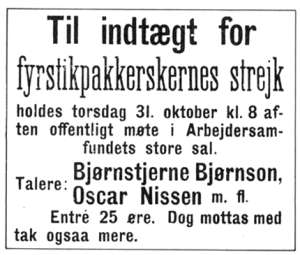|
Oscar Nissen
Elias Gottlieb Oscar Egede Nissen (31 October 1843 – 4 January 1911) was a Norwegian physician, newspaper editor and politician. He belonged to the Norwegian Labour Party from 1889 to his death, and was both party leader, party secretary as well as editor of the party organ ''Social-Demokraten'' for a period. He also made his mark as a campaigner for temperance and better health conditions. He was also chairman of the Norwegian Santal Mission. Personal life Nissen was born in Tromsø as the son of physician Heinrich Nissen (1802–1866) and Fayette Ørbech (1806–1884). His father had migrated from Holstein to Norway in 1825, and his mother was born at Falster. Through his mother, Oscar Nissen was a descendant of missionary Hans Egede. Nissen first married pianist Erika Lie. The marriage lasted from 1874 to 1895, and they had a daughter, Erika Nissen-Lie, born in 1878, and a son, Karl Nissen, born in 1879. Oscar Nissen married Fernanda Nissen in 1895. He was the uncle of pol ... [...More Info...] [...Related Items...] OR: [Wikipedia] [Google] [Baidu] |
Karl Nissen
Karl Nissen (February 27, 1879 – May 14, 1920) was a Norwegian pianist, teacher, music journalist, and conductor. Nissen was born in Kristiania (now Oslo), the son of the physician Oscar Nissen and pianist Erika Nissen, and he was taught piano by his mother. He first performed publicly at one of his mother's concerts in 1897. Nissen studied under Ferruccio Busoni in Berlin, and made concert trips to Berlin, Prague, Antwerp, Odessa, and several places in Scandinavia. He then settled down in his hometown and gave concerts that included, among others, the actress Gyda Christensen from 1908 to 1910. He also gave a number of duo concerts together with pianists Nils Larsen and Fridtjof Backer-Grøndahl, including Mozart's double concerto for two pianos. In 1907, Nissen married Aagot Kavli, an actress at the National Theatre and the sister of the painter Arne Kavli. Nissen was a teacher at the Oslo Conservatory of Music. Among his students were David Monrad Johansen and Elisabe ... [...More Info...] [...Related Items...] OR: [Wikipedia] [Google] [Baidu] |
Second Schleswig War
The Second Schleswig War ( da, Krigen i 1864; german: Deutsch-Dänischer Krieg) also sometimes known as the Dano-Prussian War or Prusso-Danish War was the second military conflict over the Schleswig-Holstein Question of the nineteenth century. The war began on 1 February 1864, when Prussian and Austrian forces crossed the border into the Danish fief Schleswig. Denmark fought the Kingdom of Prussia and the Austrian Empire. Like the First Schleswig War (1848–1852), it was fought for control of the duchies of Schleswig, Holstein and Lauenburg. Succession disputes concerning the duchies arose when the Danish king died without an heir acceptable to the German Confederation. The war started after the passing of the History of Schleswig-Holstein#The November Constitution, November Constitution of 1863, which tied Duchy of Schleswig more closely to the Denmark, Danish kingdom, which was viewed by the German side as a violation of the London Protocol (1852), London Protocol. The war en ... [...More Info...] [...Related Items...] OR: [Wikipedia] [Google] [Baidu] |
øre
Øre (plural ''øre'', ) is the centesimal subdivision of the Danish and Norwegian krones. The Faroese division is called the ''oyra'', but is equal in value to the Danish coin. Before their discontinuation, the corresponding divisions of the Swedish krona and the Icelandic króna were the öre and the eyrir, respectively. The name ''øre/öre'' derives from the Latin word ''aereus/aurum'', meaning gold. The Norwegian 10-øre coin was deprecated on 23 February 1992 and ceased to be legal tender in 1993. From then on, the only Norwegian coin in use with a value below NOK 1 was the 50-øre coin, which was also deprecated on 1 May 2012. The original value were the 1-, 2-, 5-, 10-, 25- and 50-øre coins. The Danish 25 øre coin ceased to be legal tender on 1 October 2008. The only Danish coin currently in use with a value below DKK 1 is the 50 øre. See also * Heller (money) (subdivision of Czech and Slovak crowns) * Fillér (subdivision of Hungarian Forint) * Other coin names ... [...More Info...] [...Related Items...] OR: [Wikipedia] [Google] [Baidu] |
Match Factory Workers' Strike, 1889
A match is a tool for starting a fire. Typically, matches are made of small wooden sticks or stiff paper. One end is coated with a material that can be ignited by friction generated by striking the match against a suitable surface. Wooden matches are packaged in matchboxes, and paper matches are partially cut into rows and stapled into matchbooks. The coated end of a match, known as the match "head", consists of a bead of active ingredients and binder, often colored for easier inspection. There are two main types of matches: safety matches, which can be struck only against a specially prepared surface, and strike-anywhere matches, for which any suitably frictional surface can be used. Because of the substance used to coat each match, this makes them non-biodegradable. Etymology Historically, the term ''match'' referred to lengths of cord (later cambric) impregnated with chemicals, and allowed to burn continuously. These were used to light fires and fire guns (see matchlock) a ... [...More Info...] [...Related Items...] OR: [Wikipedia] [Google] [Baidu] |


